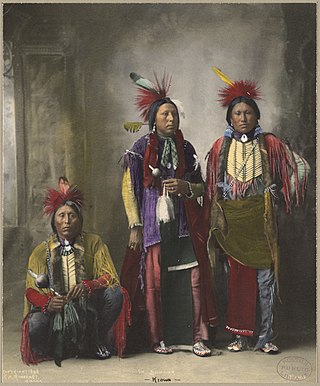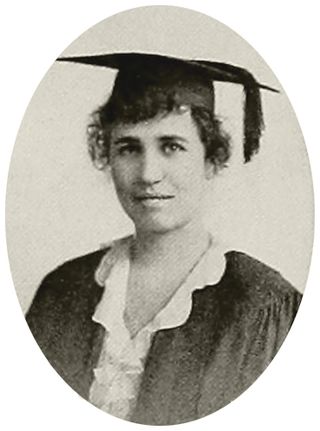Related Research Articles
Blackbear Bosin was a self-taught Comanche/Kiowa sculptor, painter, and commercial artist. He is also known by his Kiowa name, Tsate Kongia, which means "black bear."

Kiowa or CáuigúIPA:[kɔ́j-gʷú]) people are a Native American tribe and an Indigenous people of the Great Plains of the United States. They migrated southward from western Montana into the Rocky Mountains in Colorado in the 17th and 18th centuries, and eventually into the Southern Plains by the early 19th century. In 1867, the Kiowa were moved to a reservation in southwestern Oklahoma.
Kiowa music is the music of the Kiowa Tribe of Oklahoma. The Kiowa are a federally recognized tribe, meaning they have a functioning government-to-government relationship with the United States government.

Tommy Wayne Cannon was an important Native American artist of the 20th century. He was popularly known as T. C. Cannon. He was an enrolled member of the Kiowa Indian Tribe of Oklahoma and had Caddo and French ancestry.

For state legislator of Borth Carolina Alexander C. McIntosh see North Carolina General Assembly of 1899–1900
The Kiowa Six, previously known as the Kiowa Five, is a group of six Kiowa artists from Oklahoma in the early 20th century, working in the "Kiowa style". The artists were Spencer Asah, James Auchiah, Jack Hokeah, Stephen Mopope, Monroe Tsatoke and Lois Smoky.
Spencer Asah was a Kiowa painter and a member of the Kiowa Six from Oklahoma.
James Auchiah (1906–1974) was a Kiowa painter and one of the Kiowa Six from Oklahoma.
Monroe Tsatoke (1904–1937) was a Kiowa painter and a member of the Kiowa Six from Oklahoma.
Stephen Mopope (1898–1974) was a Kiowa painter, dancer, and Native American flute player from Oklahoma. He was the most prolific member of the group of artists known as the Kiowa Six.
Lois Smoky Kaulaity (1907–1981) was a Kiowa beadwork artist and a painter, one of the Kiowa Six, from Oklahoma.
Walter Richard West Sr., was a painter, sculptor, and educator. He led the Art Department at Bacone College from 1947 to 1970. He later taught at Haskell Institute for several years. West was an enrolled citizen of the Cheyenne and Arapaho Tribes.
The Bacone school or Bacone style of painting, drawing, and printmaking is a Native American intertribal "Flatstyle" art movement, primarily from the mid-20th century in Eastern Oklahoma and named for Bacone College. This art movement bridges historical, tribally-specific pictorial painting and carving practices towards an intertribal Modernist style of easel painting. This style is also influenced by the art programs of Chilocco Indian School, north of Ponca City, Oklahoma, and Haskell Indian Industrial Training Institute, in Lawrence, Kansas and features a mix of Southeastern, Prairie, and Central Plains tribes.
David Emmett Williams was a Native American painter, who was Kiowa/Tonkawa/Kiowa-Apache from Oklahoma. He studied with Dick West at Bacone College and won numerous national awards for his paintings. He painted in the Flatstyle technique that was taught at Bacone from the 1940s to the 1970s.

Susie Peters was an American preservationist and matron at the Anadarko Agency, who worked to promote Kiowa artists. Born to white parents in Tennessee, she moved to Indian Territory with her family prior to Oklahoma becoming a state. While working as a matron for the Indian Agency, she discovered the talent of the young artists who would become known as the Kiowa Six and introduced them to Oscar Jacobson, director of the University of Oklahoma's art department. She was honored by the National Hall of Fame for Famous American Indians and both adopted by the tribe and given a Kiowa name in 1954. In 1963, the Anadarko Philomathic Club created an annual art award in her name. She was inducted into the Oklahoma Women's Hall of Fame in its inaugural year, 1982.

Edith Mahier was an American artist and art instructor who was instrumental in helping develop the talent of the Kiowa Six during their studies at the University of Oklahoma. In 1941, she won the commission to complete the post office mural for the U.S. Treasury Department's Section of Fine Arts at the Watonga, Oklahoma, facility. In her later career at OU she created a division of the arts department dedicated to fashion and even designed motifs for a clothing line developed by Neiman Marcus.

Southern Plains Indian Museum is a Native American museum located in Anadarko, Oklahoma. It was opened in 1948 under a cooperative governing effort by the United States Department of the Interior and the Oklahoma state government. The museum features cultural and artistic works from Oklahoma tribal peoples of the Southern Plains region, including the Caddo, Chiricahua Apache, Comanche, Delaware Nation, Kiowa, Plains Apache, Southern Arapaho, Southern Cheyenne, and Wichita.

Oscar Brousse Jacobson was a Swedish-born American painter and museum curator. From 1915 to 1945, he was the director of the University of Oklahoma's School of Art, later known as the Fred Jones Jr. Museum of Art. He curated exhibitions and wrote books about Native American art.
References
- Lester, Patrick D. The Biographical Directory of Native American Painters. Norman and London: The Oklahoma University Press, 1995. ISBN 0-8061-9936-9.
- Lydia L. Wyckoff, ed. Visions and voices : Native American painting from the Philbrook Museum of Art. Tulsa, OK: Philbrook Museum of Art, 1996. ISBN 0-86659-013-7